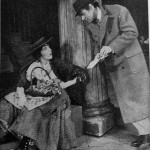My Fair Lady has been called “the perfect musical,” but it took several decades and several attempts before George Bernard Shaw’s 1913 play Pygmalion eventually found its singing voice. The journey began in the 1930s with a chance encounter between Nobel laureate Shaw and struggling film-maker Gabriel Pascal on a Mediterranean beach. Shaw enjoyed Pascal’s enthusiasm and bravado, the story goes, so he told the young man to call him if he was ever in need. A few years later, Pascal did — and managed to leave the meeting with the rights to Shaw’s plays.
Pascal’s first move was to film Pygmalion, which became an international hit. He then tried to convince Shaw to turn it into a musical, but Shaw had a bad experience with the adaptation of Arms and the Man and refused. After Shaw died in 1950, Pascal turned his thoughts again to the musical. Richard Rodgers and Oscar Hammerstein were interested, but they abandoned the idea as unworkable.
Eventually, Pascal asked Alan Jay Lerner, but as other writers had, he and partner Frederick Loewe gave up. Two years later, though, Lerner began thinking about the musical again and realized that he didn’t need to follow the “rules” for adaptations, which had begun to fossilize in the years since since Oklahoma! He saw that Shaw’s play needed few changes apart from “adding the action that took place between the acts of the play.”
Indeed, Lerner (book and lyrics) and Loewe (music) changed little in the story of Cockney flower girl Eliza Doolittle and elocution professor Henry Higgins other than adding several scenes that Shaw had subsequently written for Pascal’s 1938 film, including the Embassy Ball sequence and the ending.
After tryouts in New Haven, Conn., and Philadelphia, the show opened March 15, 1956, at Broadway’s Mark Hellinger Theatre and ran a record-breaking 2,717 performances, surpassing Oklahoma! as the longest-running musical. The original cast included Julie Andrews (Eliza) and Rex Harrison (Henry) as well as Robert Coote (Pickering) and Stanley Holloway (Doolittle), with direction by Moss Hart and choreography by Hanya Holm. New York Herald Tribune critic Walter Kerr called it “a miraculous musical,” and New York Times critic Brooks Atkinson declared it “one of the best musicals of the century.”
The production won six Tony Awards, including best musical, leading actor (Harrison), and director (Hart). The original cast recording became the best-selling album of 1956, topping the charts for 15 weeks and remaining on Billboard’s album chart for 480 weeks, one of the longest runs of any recording. In 1977, the album was inducted into the Grammy Hall of Fame.
The Oscar-winning film adaptation premiered in 1964. Harrison (Henry) and Holloway (Doolittle) reprised their roles, with Audrey Hepburn as the new Eliza (her singing dubbed by Marni Nixon) and Wilfrid Hyde-White as Pickering. Lerner contributed the screenplay, directed by George Cukor.
Listen to the 1956 original cast recording, still the best version of the show. To learn about the musical’s creation, read Keith Garebian’s The Making of My Fair Lady (1993). To compare the original play script and the musical libretto, read the Signet Classic edition (1980), which includes both.
NEXT, for another faithful play adaptation, listen to Hello, Dolly! (1964), written by Michael Stewart (book) and Jerry Herman (music and lyrics), based on Thornton Wilder’s The Matchmaker (1954).
THEN, for another adaptation of British literature, listen to Oliver! (1962), written by Lionel Bart (book, music, and lyrics), based on the Charles Dickens novel Oliver Twist (1839).

